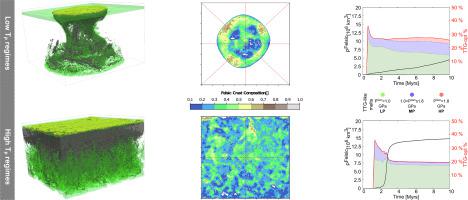当前位置:
X-MOL 学术
›
Gondwana Res.
›
论文详情
Our official English website, www.x-mol.net, welcomes your
feedback! (Note: you will need to create a separate account there.)
Plume — lid interactions during the Archean and implications for the generation of early continental terranes
Gondwana Research ( IF 7.2 ) Pub Date : 2020-12-01 , DOI: 10.1016/j.gr.2020.06.024 Andrea Piccolo , Boris J.P. Kaus , Richard W. White , Richard M. Palin , Georg S. Reuber
Gondwana Research ( IF 7.2 ) Pub Date : 2020-12-01 , DOI: 10.1016/j.gr.2020.06.024 Andrea Piccolo , Boris J.P. Kaus , Richard W. White , Richard M. Palin , Georg S. Reuber

|
Abstract Many Archean terranes are interpreted to have a tectonic and metamorphic evolution that indicates intra-crustal reorganization driven by lithospheric-scale gravitational instabilities. These processes are associated with the production of a significant amount of felsic and mafic crust, and are widely regarded to be a consequence of plume-lithosphere interactions. The juvenile Archean felsic crust is made predominantly of rocks of the tonalite–trondhjemite–granodiorite (TTG) suite, which are the result of partial melting of hydrous metabasalts. The geodynamic processes that have assisted the production of juvenile felsic crust, are still not well understood. Here, we perform 2D and 3D numerical simulations coupled with the state-of-the-art of petrological thermodynamical modelling to study the tectonic evolution of a primitive Archean oceanic plateau with particular regard on the condition of extraction of felsic melts. In our numerical simulations, the continuous emplacement of new, dry mafic intrusions and the extraction of the felsic melts, generate an unstable lower crust which drips into the mantle soon after the plume arrival. The subsequent tectonic evolution depends on the asthenosphere TP. If the TP is high enough (≥ 1500 ∘C) the entire oceanic crust is recycled within 2 Myrs. By contrast at low TP, the thin oceanic plateau slowly propagates generating plate-boundary like features.
中文翻译:

羽——太古宙期间的盖子相互作用以及对早期大陆地体产生的影响
摘要 许多太古代地体被解释为具有构造和变质演化,表明岩石圈尺度重力不稳定性驱动的地壳内重组。这些过程与大量长英质和镁铁质地壳的产生有关,并且被广泛认为是羽流-岩石圈相互作用的结果。年轻的太古宙长英质地壳主要由英长岩-长闪长岩-花岗闪长岩 (TTG) 组的岩石组成,这是含水变玄武岩部分熔融的结果。促进新生长英质地壳产生的地球动力学过程仍然不是很清楚。这里,我们执行 2D 和 3D 数值模拟,结合最先进的岩石学热力学建模,研究原始太古代海洋高原的构造演化,特别是在长英质熔体的提取条件下。在我们的数值模拟中,新的、干燥的镁铁质侵入体的连续侵位和长英质熔体的提取,产生了不稳定的下地壳,在羽流到达后不久就会滴入地幔。随后的构造演化取决于软流圈 TP。如果 TP 足够高(≥ 1500 ∘C),整个洋壳在 2 Myrs 内循环。相比之下,在低 TP 时,薄的海洋高原缓慢传播,产生类似板块边界的特征。新的、干燥的镁铁质侵入体的持续侵位和长英质熔体的提取,产生了不稳定的下地壳,在羽流到达后不久便滴入地幔。随后的构造演化取决于软流圈 TP。如果 TP 足够高(≥ 1500 ∘C),整个洋壳在 2 Myrs 内循环。相比之下,在低 TP 时,薄的海洋高原缓慢传播,产生类似板块边界的特征。新的、干燥的镁铁质侵入体的持续侵位和长英质熔体的提取,产生了不稳定的下地壳,在羽流到达后不久便滴入地幔。随后的构造演化取决于软流圈 TP。如果 TP 足够高(≥ 1500 ∘C),整个洋壳在 2 Myrs 内循环。相比之下,在低 TP 时,薄的海洋高原缓慢传播,产生类似板块边界的特征。
更新日期:2020-12-01
中文翻译:

羽——太古宙期间的盖子相互作用以及对早期大陆地体产生的影响
摘要 许多太古代地体被解释为具有构造和变质演化,表明岩石圈尺度重力不稳定性驱动的地壳内重组。这些过程与大量长英质和镁铁质地壳的产生有关,并且被广泛认为是羽流-岩石圈相互作用的结果。年轻的太古宙长英质地壳主要由英长岩-长闪长岩-花岗闪长岩 (TTG) 组的岩石组成,这是含水变玄武岩部分熔融的结果。促进新生长英质地壳产生的地球动力学过程仍然不是很清楚。这里,我们执行 2D 和 3D 数值模拟,结合最先进的岩石学热力学建模,研究原始太古代海洋高原的构造演化,特别是在长英质熔体的提取条件下。在我们的数值模拟中,新的、干燥的镁铁质侵入体的连续侵位和长英质熔体的提取,产生了不稳定的下地壳,在羽流到达后不久就会滴入地幔。随后的构造演化取决于软流圈 TP。如果 TP 足够高(≥ 1500 ∘C),整个洋壳在 2 Myrs 内循环。相比之下,在低 TP 时,薄的海洋高原缓慢传播,产生类似板块边界的特征。新的、干燥的镁铁质侵入体的持续侵位和长英质熔体的提取,产生了不稳定的下地壳,在羽流到达后不久便滴入地幔。随后的构造演化取决于软流圈 TP。如果 TP 足够高(≥ 1500 ∘C),整个洋壳在 2 Myrs 内循环。相比之下,在低 TP 时,薄的海洋高原缓慢传播,产生类似板块边界的特征。新的、干燥的镁铁质侵入体的持续侵位和长英质熔体的提取,产生了不稳定的下地壳,在羽流到达后不久便滴入地幔。随后的构造演化取决于软流圈 TP。如果 TP 足够高(≥ 1500 ∘C),整个洋壳在 2 Myrs 内循环。相比之下,在低 TP 时,薄的海洋高原缓慢传播,产生类似板块边界的特征。











































 京公网安备 11010802027423号
京公网安备 11010802027423号